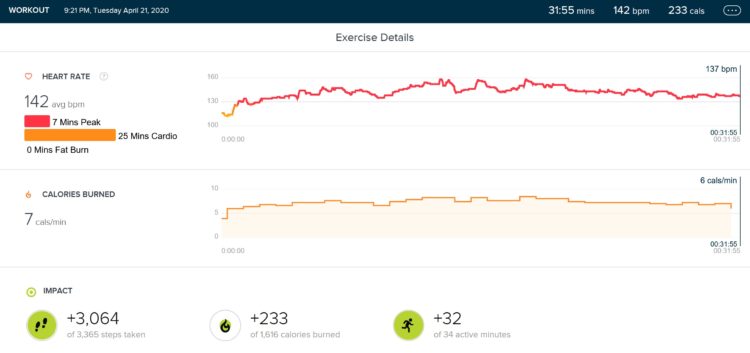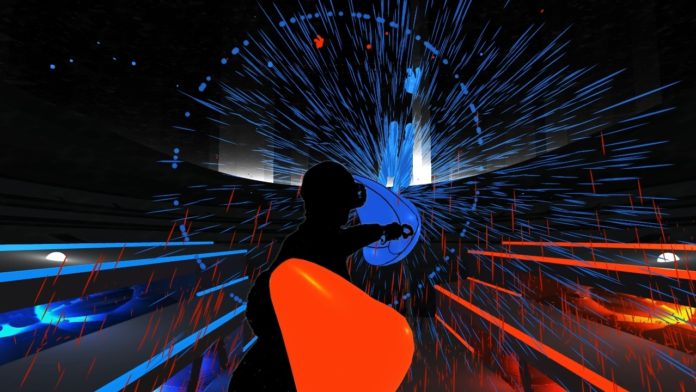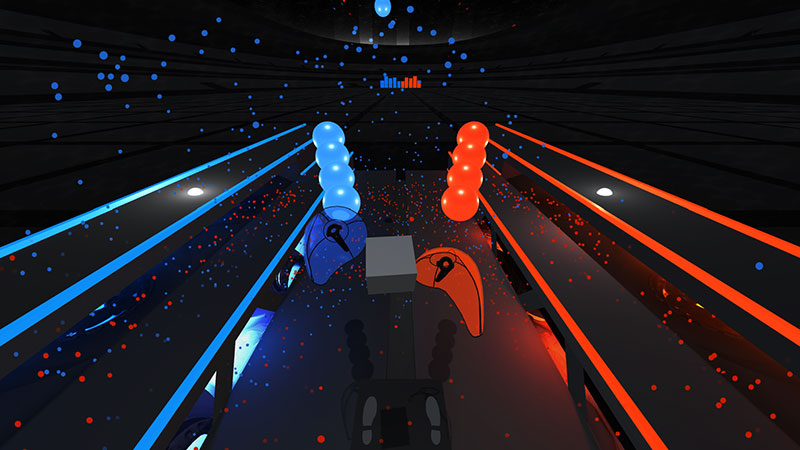Audioshield is the original virtual reality rhythm game, birthing the medium’s most popular, some might argue derivative genre when it launched way back in 2016. Immediately a hit with Steam VR users, Audioshield racked up thousands of positive reviews on the service. Users loved it for its ability to easily play your own songs, and for the Youtube integration that let you not only play the song but also watch the music video on a giant screen in front of you. It was great, but sadly and rather inevitably Youtube ordered its removal.
Unhappy with losing what they regarded as a key feature, many users complained, abandoned the game, and then along came Beat Saber… Audioshield became something of a distant memory, all but forgotten, but now has a surprise reemergence on the Oculus Quest platform.
Audioshield works by translating musical notes into flying orbs that rain down upon you. Rather than slicing a la Beat Saber, here you hold twin shields, one red, one blue which act as defensive weapons. You must match the red shield to the red notes, blue shield to the blue notes. Single notes can be punched into oblivion whilst long chains will eviscerate against your shields in a pleasing hail of particular explosions. Occasionally you’ll be faced with a stream of purple notes, which you must defend against by holding your shields together.
Dated Gameplay
On the normal game mode, I find playing this version somewhat bittersweet. The gameplay, which back in 2017 seemed exhilarating to me as a VR newbie, now feels rather lacking compared to the polished, addictive, rhythmic perfection of Beat Saber. The 20 included songs are largely forgettable and no songs have any particular character to them. If you are familiar with Beat Saber, or SynthRiders you’ll instantly be able to recall the moves of your favorite tracks, they feel like a choreographed dance. In Audioshield I don’t feel as if I’m experiencing a song and moving to its beat, it’s more a case of objects raining down on me and I’m defending, whilst music happens to be being played. This isn’t always the case, some songs certainly induce some epic moments, but not nearly as consistently as Beat Saber does. It doesn’t help that there are absolutely no sound effects in the menu whatsoever. Initially, I actually thought my earphones weren’t plugged in properly as during the first song the musical notes made their way silently towards me until the first note hit my shield and the soundtrack kicked off. It makes the port feel a bit lazy and gives a bad initial impression. Fortunately, my experience picked up a lot from that point on, however.
Excellent Fitness Mode
Whilst the rhythm gameplay may be dated, nor as fun or fluid to play as the best the modern VR rhythm genre has to offer, the Quest version of Audioshield has added a dedicated fitness mode and borrowed one element from BoxVR and Beat Saber that really saves the title for me. That’s the inclusion of triangular walls that require you to squat to duck under them. If you’re looking for an active title to use with aiding weight loss and cardio this changes the game and its value entirely! Let’s just say fitness mode is no joke, and in combination with being able to use your own music library turns what might otherwise have been a disappointing port into an excellent choice for fitness enthusiasts, looking to train to their own music.
Preparation
Since its beginnings, Audioshield has always had a reputation for providing a stellar workout so I sweat prepared my headset by wearing a headband and using a wipeable VR cover. I completed my 30-minute training session using the full fitness workout mode and selected a mix of in-game tracks and some of my own. I felt I should only use songs I legally owned and could download from my Amazon account. As someone who generally listens to Bon Iver and Laura Marling, this didn’t give me a great selection of active albums to pick from. I ended up going with the Kings of Leon ‘Only by the Night’ album, songs from the ‘Brothers’ album by the Black Keys, and finally some hardcore death metal from Aussie band Parkway Drive.
Below you can see me playing Howlin for You, by the Black Keys. One cool feature I like is the crowd in the arena below you. Like an army of brocken spectra they mirror your movements, a little touch that I enjoyed.
To use my own music I loaded up Sidequest to connect my Quest to my PC and dragged the albums into my music folder. You can also use Dropbox. The game didn’t initially find my songs as I had them in separate folders but removing the folders fixed that problem. I was concerned there might be a lengthy delay whilst the program beat mapped each of my songs, but they actually loaded up as quickly as songs bundled on the game itself, which was good news.
Finally, I used my old Fitbit Charge 2 to record the session and also used YUR which you can download completely for free on Sidequest.
This next clip is one of the included tracks Frozen Cortex. It’s ok, but using your library is obviously preferable.
Intensity 8.5/10

- Calories burned:233
- Calories per minute:7
- Average heart rate:142
- Max heart rate:158
- Steps:3064
- Active Minutes:32
YUR recorded 270 calories for the session and counted 271 squats.
As a modded version of Audioshield on PC VR remains the most physically demanding VR game ever tested by the https://vrhealth.institute/ I had high hopes that the new fitness mode on the Quest would be a decent workout. It lived up to my expectations and my legs are certainly feeling it today!
Arms 7/10
As with all rhythm games, this is a decent arm and shoulder workout. Whilst you can punch the musical orbs and are scored for the amount of force used a lot of the time is spent blocking rather than actively swiping however so it’s not as intense an arm workout as Beat Saber or BoxVR. Unlike those games where musical notes almost always approach at shoulder height level in Audioshield, they often rain down almost overhead, meaning you will be lifting your shoulders much higher than in those titles, which can add some workout variation.
Legs 9/10
The fitness mode is no joke when it comes to leg training. According to YUR, I did 271 squats during my session and certainly felt it the next day. If you are looking to build strength then adding a weighted vest will allow for progressive overload training and significant extra calorie expenditure. I found my legs were worked considerably harder here than with Beat Saber, and comparable to BoxVR’s heavier leg focused sessions. One difference with Audioshield to BoxVR is that the music advances towards you in time with the beat. Any pause in the soundtrack will cause the musical notes, and triangles you duck under to freeze, a bit like Superhot. This means selecting songs with musical pauses can often have you ducking under a triangle then being forced to hold the position for an extra second or so until the music kicks back in and the triangle moves past you. I found this significantly added to the tension felt in my legs, hence the very high 9/10 rating.
Core and Balance 8/10
The fitness mode regularly mixes up the positions of the red and blue notes requiring you to cross your arms Twister style and bash the orbs as they appear on the opposite side from your shield. This twisting, combined with the constant plethora of squats required before returning to a standing position and reaching high with your shoulders to block an overhead attack serves to give your core a decent workout. It felt like I was being worked in every direction.
Time Perception 7/10
This game is not nearly as fun to play as Beat Saber’s sublimely crafted levels. Whereas in Beat Saber I feel like I’m learning a series of choreographed moves, and it really feels like a musical rhythm, here I feel more like I’m playing a kind of space invaders and having to stop the musical orbs from landing on me. It’s fun and tiring but doesn’t feel like I’m interacting with the music as much as the music is playing whilst I bash the orbs. This reduces the flow factor but that is compensated somewhat by the fact you can listen to your own music. If you have a favorite album that you love listening to, working out to it in this fashion will be easily motivating enough to pull you through a thirty-minute workout. I certainly wasn’t bored or done after my playtest but neither did I feel the same exhilaration I get working through Beat Saber’s ‘Imagine Dragons’ DLC pack.
Replayability 8/10
The gameplay is fairly simplistic and dated in 2020 but with the ability to play your own music whilst getting a fantastic cardio and leg workout it’s a game that could keep you going for a long time.
Fitness Scalability 9/10
On normal mode, this game is very gentle and easy, with each difficulty level increasing the physical effort required. Song selection will also have an impact so people of all fitness levels should be able to play this without issue. For those who want to push themselves, the full fitness mode, combined with a weighted vest and some fast-paced tunes will give you as hard a bodyweight workout as anything else in VR right now.
Lack of Nausea 9/10
The game is played on a stationary platform with no artificial movement whatsoever. Therefore motion sickness should not be an issue for anybody.
Social Competition 1/10
This is a single-player only game and as everybody using it will likely be playing their own music there’s no leaderboards or community competition to compare scores with at all. There is an in-game scoring system that scores accuracy, technique, and force, but I doubt people will pay it any attention whatsoever. I certainly didn’t.
VRFI Fit Score 8.5/10
Judged as a rhythm game this no longer measures up well to Beat Saber or Synth Riders, the two best selling competitor games on Quest. The fitness mode feels more like BoxVR than those games to me and therefore I’m comparing it as a workout option to that game. In terms of calories burned and the effort required I’d say its equal to BoxVR, and the ability to easily import your own songs, with no time delay for beat mapping means it’s a great alternative if you fancy something a little different.
For VR fitness fans who find the soundtracks of other similar games not to their taste then this game is still a recommended choice for how easy it is to play your own tracks and the level of physical intensity the workouts provide.
The Good
Easily play your own songs, with minimal beat mapping delay time.
The fitness mode provides a really excellent leg centric workout.
If you’re a VR veteran like me it feels good to pay respect to the rhythm game OG that started it all.
The Bad
In a post Beat Saber world, Audioshield’s gameplay isn’t going to set the world on fire.
No sound effects at all in menus makes it feel a lazy port.
Audioshield is out now for the Oculus Quest priced $19.99 or £14.99. It’s also available for PC VR headsets on Steam.



